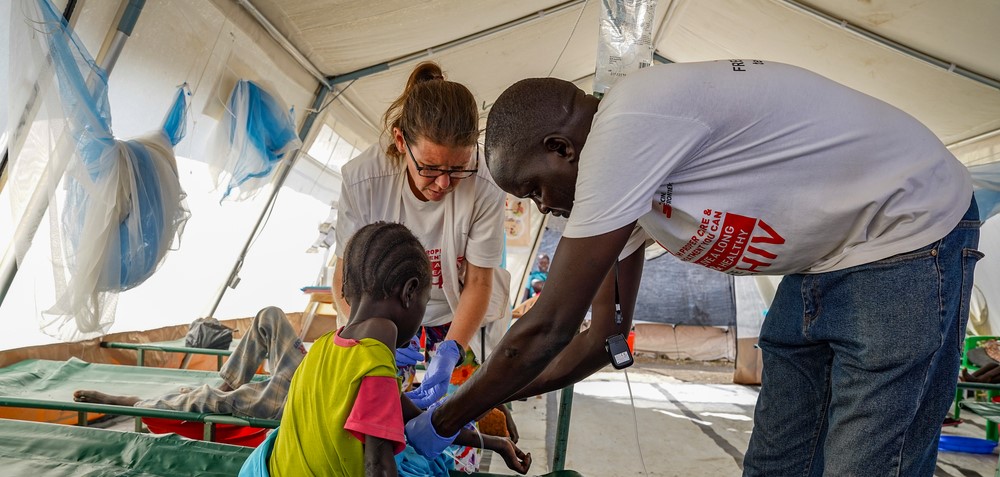I have spent a year watching a treatable disease, cholera, chew through South Sudan. And the hardest question isn’t how to treat it—we know how. The hardest question is this: Why is the outbreak not able to be contained? Why, one year after the outbreak was declared on 28 October 28, are we still fighting a preventable enemy that has already stolen over 1,500 lives and sickened over 93,000 people?
The harsh reality is that the cholera epidemic is a symptom of South Sudan’s deepest vulnerabilities: systemic neglect, incessant violence, and a fragile, underfunded healthcare system, resulting in significant service delivery gaps and lack of proper response. The scale of the outbreak is the result of a slow, underperforming and uncoordinated response – which has been a challenge since it began.
As the Deputy Medical Coordinator for MSF in South Sudan, I was directly involved in leading our medical response. Our priority was setting up Cholera Treatment Units (CTUs) and Centres to ensure patients could get timely treatment. We started in Renk, in Upper Nile State in the north of South Sudan, then moved to Malakal and Ulang,, followed by Bentiu in Unity State, and the capital, Juba. Over the next few months, our efforts rapidly expanded to numerous other areas across the country, allowing us to treat more than 35,000 people.
A worrying connection between underfunding, displacement and violence
At the heart of this crisis is the fragile nature of South Sudan’s public healthcare system, which depends almost entirely on external support. With the government allocating less than two per cent of its budget to health in recent years, the system is incapable of catering to the routine needs of its own population, let alone a robust emergency response. Moreover, existing programs are on a precarious footing as a result of long-standing challenges, including insufficient domestic and international funding and critical implementation failures. The withdrawal of support from major donors—including USAID—has forced the closure of some health facilities, eliminating crucial lifelines. In Bentiu, for instance, we witnessed how the reduction in funding to organisations that run water and sanitation and primary healthcare have left major gaps in the response, leaving people at risk while desperately searching for care.
Added to this is the influx of people who have fled to South Sudan from Sudan, increasing the burden on limited services at a time the country was facing reduced services due to funding cuts. Since April 2023 when the civil war in Sudan broke out, more than 1 million people found refuge in South Sudan, equivalent to 10 per cent of the country’s population. These vulnerable, mobile populations are often cut off from essential services, including vaccination programs, increasing their risk of both contracting and spreading the disease. The situation in transit camps in Renk—where the camps now host more than three times their capacity—illustrates the crisis perfectly.
This overcrowding, combined with poor water and sanitation and limited access to clean water, creates the perfect environment for disease to spread. It’s no surprise that this has driven the rise in other new waterborne diseases such as hepatitis E – a severe threat, especially to pregnant women.
Attacks on healthcare and the impact of violence and insecurity
Perhaps the cruellest obstacle is the pervasive violence, insecurity and attacks on healthcare.
A heart-breaking example occurred in March 2025, when fighting in Ulang forced tens of patients to flee from the MSF hospital, including more than 30 patients admitted for cholera treatment. These patients fled into the community, not only facing the risk of death themselves, but also fuelling the spread of the disease. The hospital would later be closed permanently because of looting. Since the start of the 2025, MSF has been directly targeted in more than eight attacks, closing another hospital in Old Fangak in Jonglei state, and reducing or suspending activities in others. The result is hundreds of thousands of people cut off from healthcare.
Way forward: from crisis to responsibility
We know how to prevent cholera. It’s not a mystery. But until the government, the international community, and all parties face up to their failures and ensure a unified, multi-sectoral and sustained response, we are simply waiting for the next outbreak.
The government needs to step up and take its responsibilities to take care of its people. This includes scaling up emergency preparedness and response capacities, and prioritising service delivery in hot spot locations.
The international community must provide renewed humanitarian and development support, not only to try and close the massive gaps left by recent funding cuts but also to ensure a more effective humanitarian response with the limited resources that remain. This includes scaling up sustainable programs for water and sanitation services, and widespread vaccination for both cholera and hepatitis E.
Finally, all parties to ongoing conflict must respect international humanitarian law and guarantee safe access to people in need.
Without this fundamental shift, new outbreaks will continue to occur, condemning the people of South Sudan to a bleak future of avoidable suffering.
The writer, Ilse De Boer, is Deputy Medical Coordinator, Médecins Sans Frontières (MSF) in South Sudan




